Extroversion and Child Bullies
VerifiedAdded on 2021/05/31
|7
|1536
|153
AI Summary
Extroversion and Child Bullies 7 Extroversion and Child Bullies 1 Extraversion Will Be a Leading Factor in Child Bullies by Course: Tutor: University: Department: Date: Introduction There have been significant developments in the studies of child bullying. Ewen, (2013) shows that extraverts are more likely to become active in social environments than their counterparts who undergo high levels of bullying (Ewen, 2014). Additionally, bullying has also been attributed to averagely increased rates of callous-
Contribute Materials
Your contribution can guide someone’s learning journey. Share your
documents today.
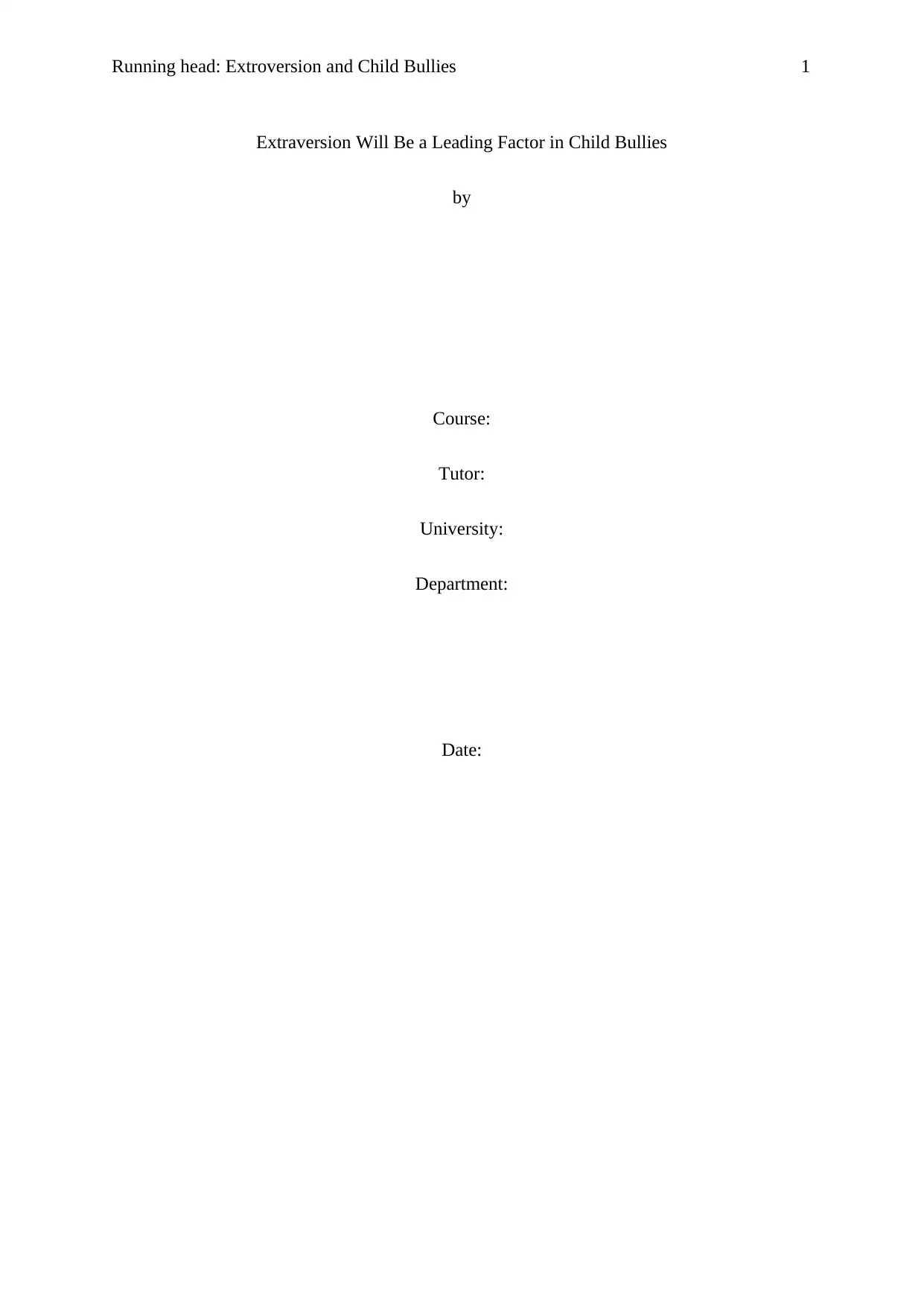
Running head: Extroversion and Child Bullies 1
Extraversion Will Be a Leading Factor in Child Bullies
by
Course:
Tutor:
University:
Department:
Date:
Extraversion Will Be a Leading Factor in Child Bullies
by
Course:
Tutor:
University:
Department:
Date:
Secure Best Marks with AI Grader
Need help grading? Try our AI Grader for instant feedback on your assignments.
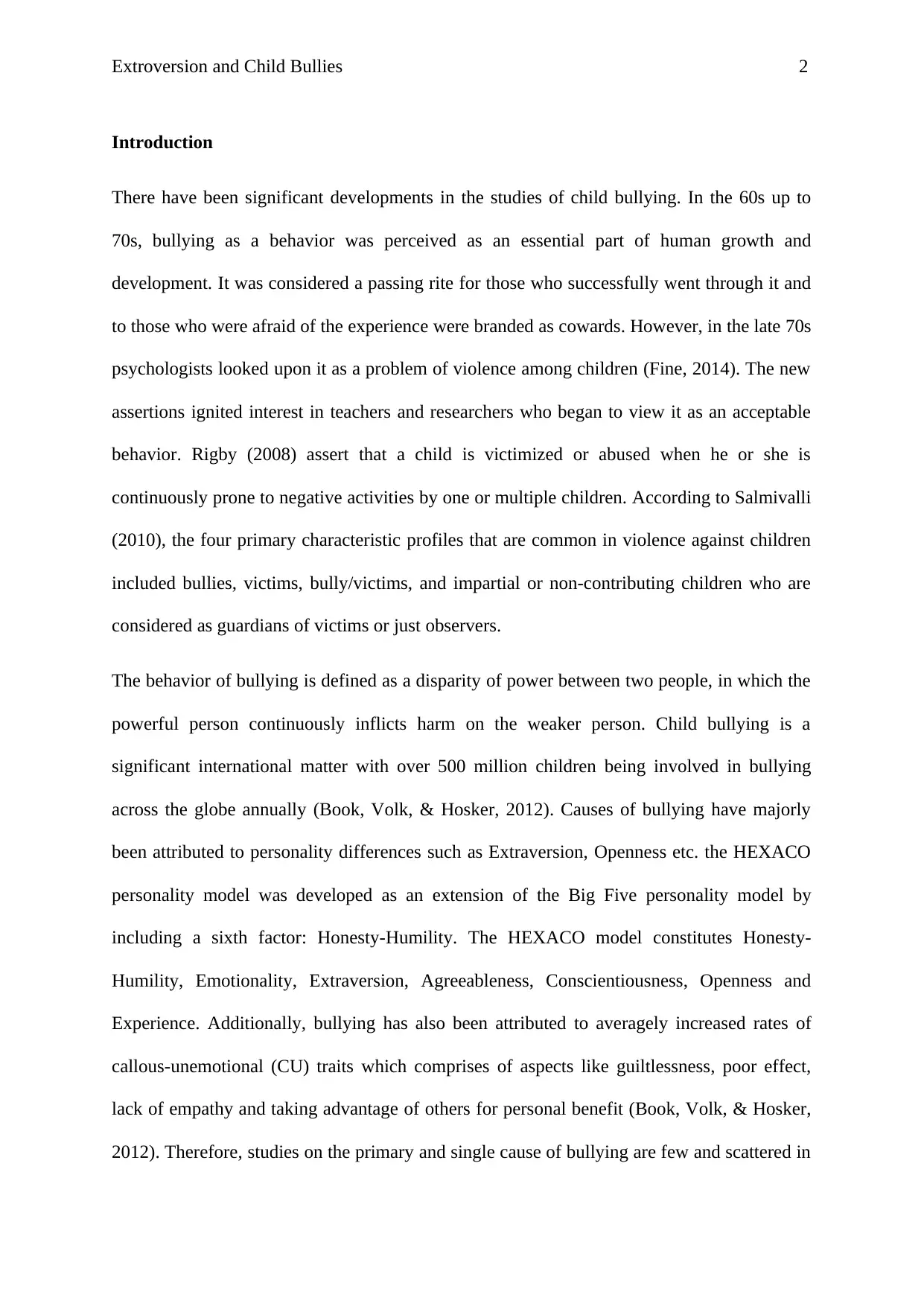
Extroversion and Child Bullies 2
Introduction
There have been significant developments in the studies of child bullying. In the 60s up to
70s, bullying as a behavior was perceived as an essential part of human growth and
development. It was considered a passing rite for those who successfully went through it and
to those who were afraid of the experience were branded as cowards. However, in the late 70s
psychologists looked upon it as a problem of violence among children (Fine, 2014). The new
assertions ignited interest in teachers and researchers who began to view it as an acceptable
behavior. Rigby (2008) assert that a child is victimized or abused when he or she is
continuously prone to negative activities by one or multiple children. According to Salmivalli
(2010), the four primary characteristic profiles that are common in violence against children
included bullies, victims, bully/victims, and impartial or non-contributing children who are
considered as guardians of victims or just observers.
The behavior of bullying is defined as a disparity of power between two people, in which the
powerful person continuously inflicts harm on the weaker person. Child bullying is a
significant international matter with over 500 million children being involved in bullying
across the globe annually (Book, Volk, & Hosker, 2012). Causes of bullying have majorly
been attributed to personality differences such as Extraversion, Openness etc. the HEXACO
personality model was developed as an extension of the Big Five personality model by
including a sixth factor: Honesty-Humility. The HEXACO model constitutes Honesty-
Humility, Emotionality, Extraversion, Agreeableness, Conscientiousness, Openness and
Experience. Additionally, bullying has also been attributed to averagely increased rates of
callous-unemotional (CU) traits which comprises of aspects like guiltlessness, poor effect,
lack of empathy and taking advantage of others for personal benefit (Book, Volk, & Hosker,
2012). Therefore, studies on the primary and single cause of bullying are few and scattered in
Introduction
There have been significant developments in the studies of child bullying. In the 60s up to
70s, bullying as a behavior was perceived as an essential part of human growth and
development. It was considered a passing rite for those who successfully went through it and
to those who were afraid of the experience were branded as cowards. However, in the late 70s
psychologists looked upon it as a problem of violence among children (Fine, 2014). The new
assertions ignited interest in teachers and researchers who began to view it as an acceptable
behavior. Rigby (2008) assert that a child is victimized or abused when he or she is
continuously prone to negative activities by one or multiple children. According to Salmivalli
(2010), the four primary characteristic profiles that are common in violence against children
included bullies, victims, bully/victims, and impartial or non-contributing children who are
considered as guardians of victims or just observers.
The behavior of bullying is defined as a disparity of power between two people, in which the
powerful person continuously inflicts harm on the weaker person. Child bullying is a
significant international matter with over 500 million children being involved in bullying
across the globe annually (Book, Volk, & Hosker, 2012). Causes of bullying have majorly
been attributed to personality differences such as Extraversion, Openness etc. the HEXACO
personality model was developed as an extension of the Big Five personality model by
including a sixth factor: Honesty-Humility. The HEXACO model constitutes Honesty-
Humility, Emotionality, Extraversion, Agreeableness, Conscientiousness, Openness and
Experience. Additionally, bullying has also been attributed to averagely increased rates of
callous-unemotional (CU) traits which comprises of aspects like guiltlessness, poor effect,
lack of empathy and taking advantage of others for personal benefit (Book, Volk, & Hosker,
2012). Therefore, studies on the primary and single cause of bullying are few and scattered in
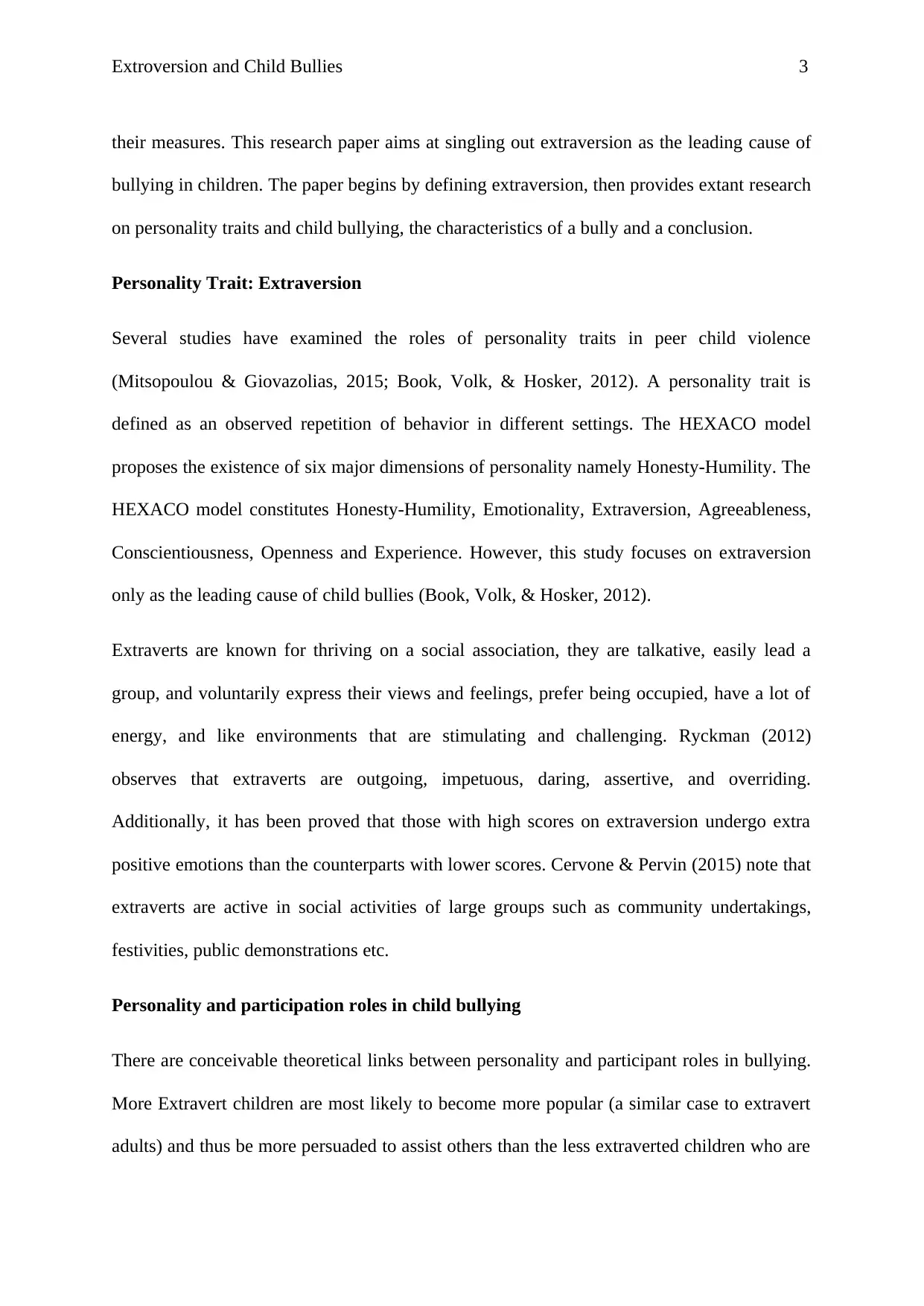
Extroversion and Child Bullies 3
their measures. This research paper aims at singling out extraversion as the leading cause of
bullying in children. The paper begins by defining extraversion, then provides extant research
on personality traits and child bullying, the characteristics of a bully and a conclusion.
Personality Trait: Extraversion
Several studies have examined the roles of personality traits in peer child violence
(Mitsopoulou & Giovazolias, 2015; Book, Volk, & Hosker, 2012). A personality trait is
defined as an observed repetition of behavior in different settings. The HEXACO model
proposes the existence of six major dimensions of personality namely Honesty-Humility. The
HEXACO model constitutes Honesty-Humility, Emotionality, Extraversion, Agreeableness,
Conscientiousness, Openness and Experience. However, this study focuses on extraversion
only as the leading cause of child bullies (Book, Volk, & Hosker, 2012).
Extraverts are known for thriving on a social association, they are talkative, easily lead a
group, and voluntarily express their views and feelings, prefer being occupied, have a lot of
energy, and like environments that are stimulating and challenging. Ryckman (2012)
observes that extraverts are outgoing, impetuous, daring, assertive, and overriding.
Additionally, it has been proved that those with high scores on extraversion undergo extra
positive emotions than the counterparts with lower scores. Cervone & Pervin (2015) note that
extraverts are active in social activities of large groups such as community undertakings,
festivities, public demonstrations etc.
Personality and participation roles in child bullying
There are conceivable theoretical links between personality and participant roles in bullying.
More Extravert children are most likely to become more popular (a similar case to extravert
adults) and thus be more persuaded to assist others than the less extraverted children who are
their measures. This research paper aims at singling out extraversion as the leading cause of
bullying in children. The paper begins by defining extraversion, then provides extant research
on personality traits and child bullying, the characteristics of a bully and a conclusion.
Personality Trait: Extraversion
Several studies have examined the roles of personality traits in peer child violence
(Mitsopoulou & Giovazolias, 2015; Book, Volk, & Hosker, 2012). A personality trait is
defined as an observed repetition of behavior in different settings. The HEXACO model
proposes the existence of six major dimensions of personality namely Honesty-Humility. The
HEXACO model constitutes Honesty-Humility, Emotionality, Extraversion, Agreeableness,
Conscientiousness, Openness and Experience. However, this study focuses on extraversion
only as the leading cause of child bullies (Book, Volk, & Hosker, 2012).
Extraverts are known for thriving on a social association, they are talkative, easily lead a
group, and voluntarily express their views and feelings, prefer being occupied, have a lot of
energy, and like environments that are stimulating and challenging. Ryckman (2012)
observes that extraverts are outgoing, impetuous, daring, assertive, and overriding.
Additionally, it has been proved that those with high scores on extraversion undergo extra
positive emotions than the counterparts with lower scores. Cervone & Pervin (2015) note that
extraverts are active in social activities of large groups such as community undertakings,
festivities, public demonstrations etc.
Personality and participation roles in child bullying
There are conceivable theoretical links between personality and participant roles in bullying.
More Extravert children are most likely to become more popular (a similar case to extravert
adults) and thus be more persuaded to assist others than the less extraverted children who are
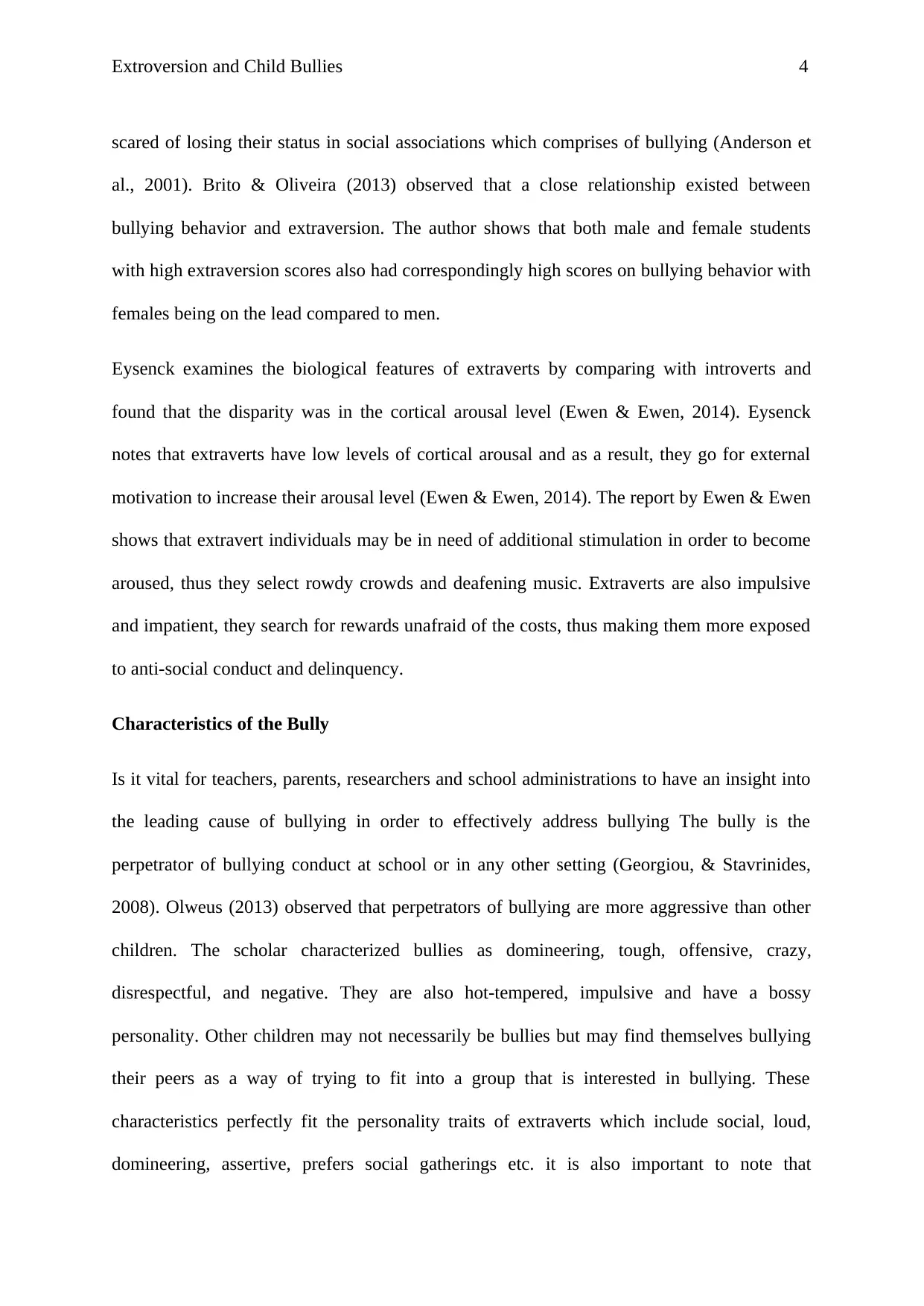
Extroversion and Child Bullies 4
scared of losing their status in social associations which comprises of bullying (Anderson et
al., 2001). Brito & Oliveira (2013) observed that a close relationship existed between
bullying behavior and extraversion. The author shows that both male and female students
with high extraversion scores also had correspondingly high scores on bullying behavior with
females being on the lead compared to men.
Eysenck examines the biological features of extraverts by comparing with introverts and
found that the disparity was in the cortical arousal level (Ewen & Ewen, 2014). Eysenck
notes that extraverts have low levels of cortical arousal and as a result, they go for external
motivation to increase their arousal level (Ewen & Ewen, 2014). The report by Ewen & Ewen
shows that extravert individuals may be in need of additional stimulation in order to become
aroused, thus they select rowdy crowds and deafening music. Extraverts are also impulsive
and impatient, they search for rewards unafraid of the costs, thus making them more exposed
to anti-social conduct and delinquency.
Characteristics of the Bully
Is it vital for teachers, parents, researchers and school administrations to have an insight into
the leading cause of bullying in order to effectively address bullying The bully is the
perpetrator of bullying conduct at school or in any other setting (Georgiou, & Stavrinides,
2008). Olweus (2013) observed that perpetrators of bullying are more aggressive than other
children. The scholar characterized bullies as domineering, tough, offensive, crazy,
disrespectful, and negative. They are also hot-tempered, impulsive and have a bossy
personality. Other children may not necessarily be bullies but may find themselves bullying
their peers as a way of trying to fit into a group that is interested in bullying. These
characteristics perfectly fit the personality traits of extraverts which include social, loud,
domineering, assertive, prefers social gatherings etc. it is also important to note that
scared of losing their status in social associations which comprises of bullying (Anderson et
al., 2001). Brito & Oliveira (2013) observed that a close relationship existed between
bullying behavior and extraversion. The author shows that both male and female students
with high extraversion scores also had correspondingly high scores on bullying behavior with
females being on the lead compared to men.
Eysenck examines the biological features of extraverts by comparing with introverts and
found that the disparity was in the cortical arousal level (Ewen & Ewen, 2014). Eysenck
notes that extraverts have low levels of cortical arousal and as a result, they go for external
motivation to increase their arousal level (Ewen & Ewen, 2014). The report by Ewen & Ewen
shows that extravert individuals may be in need of additional stimulation in order to become
aroused, thus they select rowdy crowds and deafening music. Extraverts are also impulsive
and impatient, they search for rewards unafraid of the costs, thus making them more exposed
to anti-social conduct and delinquency.
Characteristics of the Bully
Is it vital for teachers, parents, researchers and school administrations to have an insight into
the leading cause of bullying in order to effectively address bullying The bully is the
perpetrator of bullying conduct at school or in any other setting (Georgiou, & Stavrinides,
2008). Olweus (2013) observed that perpetrators of bullying are more aggressive than other
children. The scholar characterized bullies as domineering, tough, offensive, crazy,
disrespectful, and negative. They are also hot-tempered, impulsive and have a bossy
personality. Other children may not necessarily be bullies but may find themselves bullying
their peers as a way of trying to fit into a group that is interested in bullying. These
characteristics perfectly fit the personality traits of extraverts which include social, loud,
domineering, assertive, prefers social gatherings etc. it is also important to note that
Secure Best Marks with AI Grader
Need help grading? Try our AI Grader for instant feedback on your assignments.
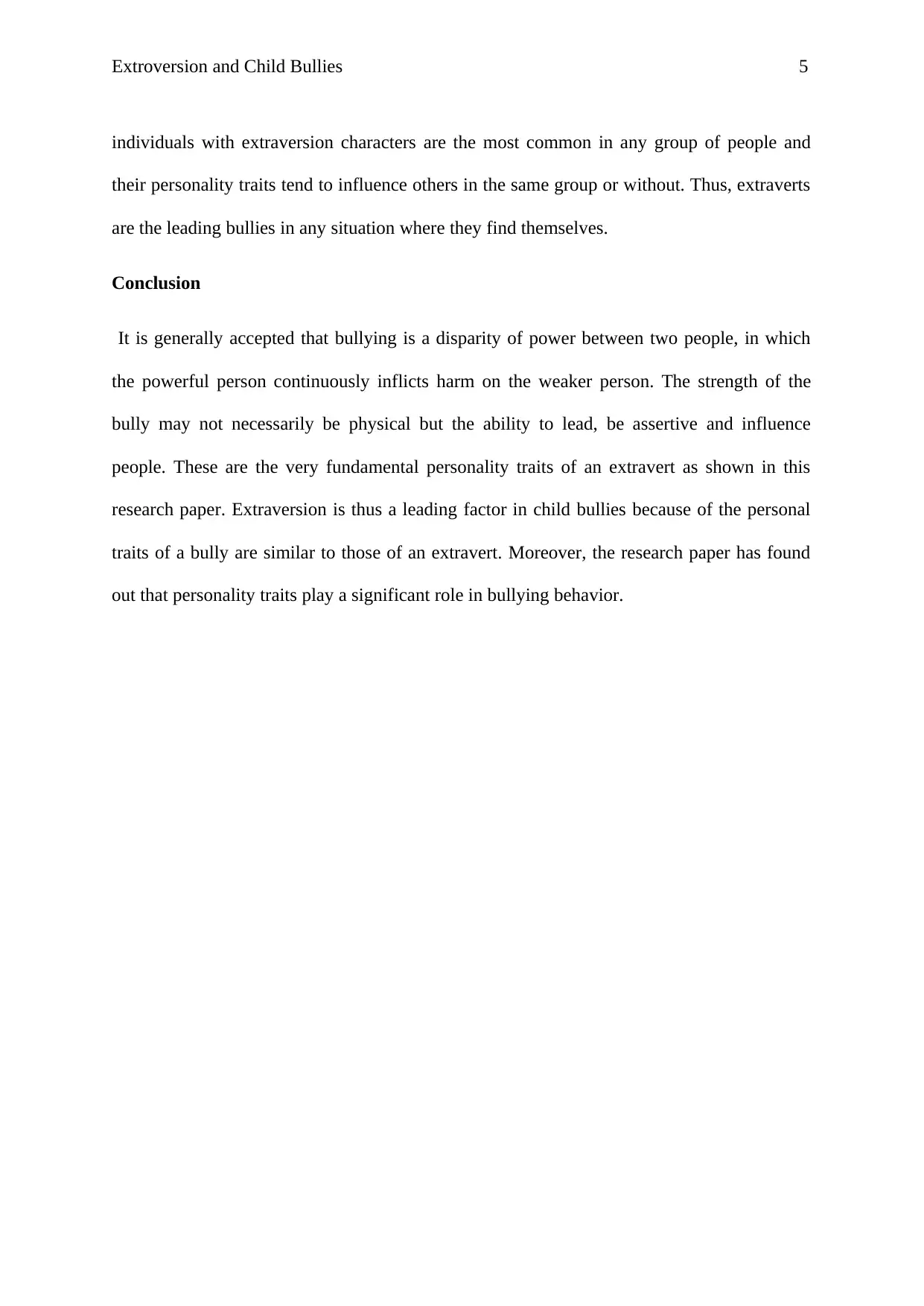
Extroversion and Child Bullies 5
individuals with extraversion characters are the most common in any group of people and
their personality traits tend to influence others in the same group or without. Thus, extraverts
are the leading bullies in any situation where they find themselves.
Conclusion
It is generally accepted that bullying is a disparity of power between two people, in which
the powerful person continuously inflicts harm on the weaker person. The strength of the
bully may not necessarily be physical but the ability to lead, be assertive and influence
people. These are the very fundamental personality traits of an extravert as shown in this
research paper. Extraversion is thus a leading factor in child bullies because of the personal
traits of a bully are similar to those of an extravert. Moreover, the research paper has found
out that personality traits play a significant role in bullying behavior.
individuals with extraversion characters are the most common in any group of people and
their personality traits tend to influence others in the same group or without. Thus, extraverts
are the leading bullies in any situation where they find themselves.
Conclusion
It is generally accepted that bullying is a disparity of power between two people, in which
the powerful person continuously inflicts harm on the weaker person. The strength of the
bully may not necessarily be physical but the ability to lead, be assertive and influence
people. These are the very fundamental personality traits of an extravert as shown in this
research paper. Extraversion is thus a leading factor in child bullies because of the personal
traits of a bully are similar to those of an extravert. Moreover, the research paper has found
out that personality traits play a significant role in bullying behavior.
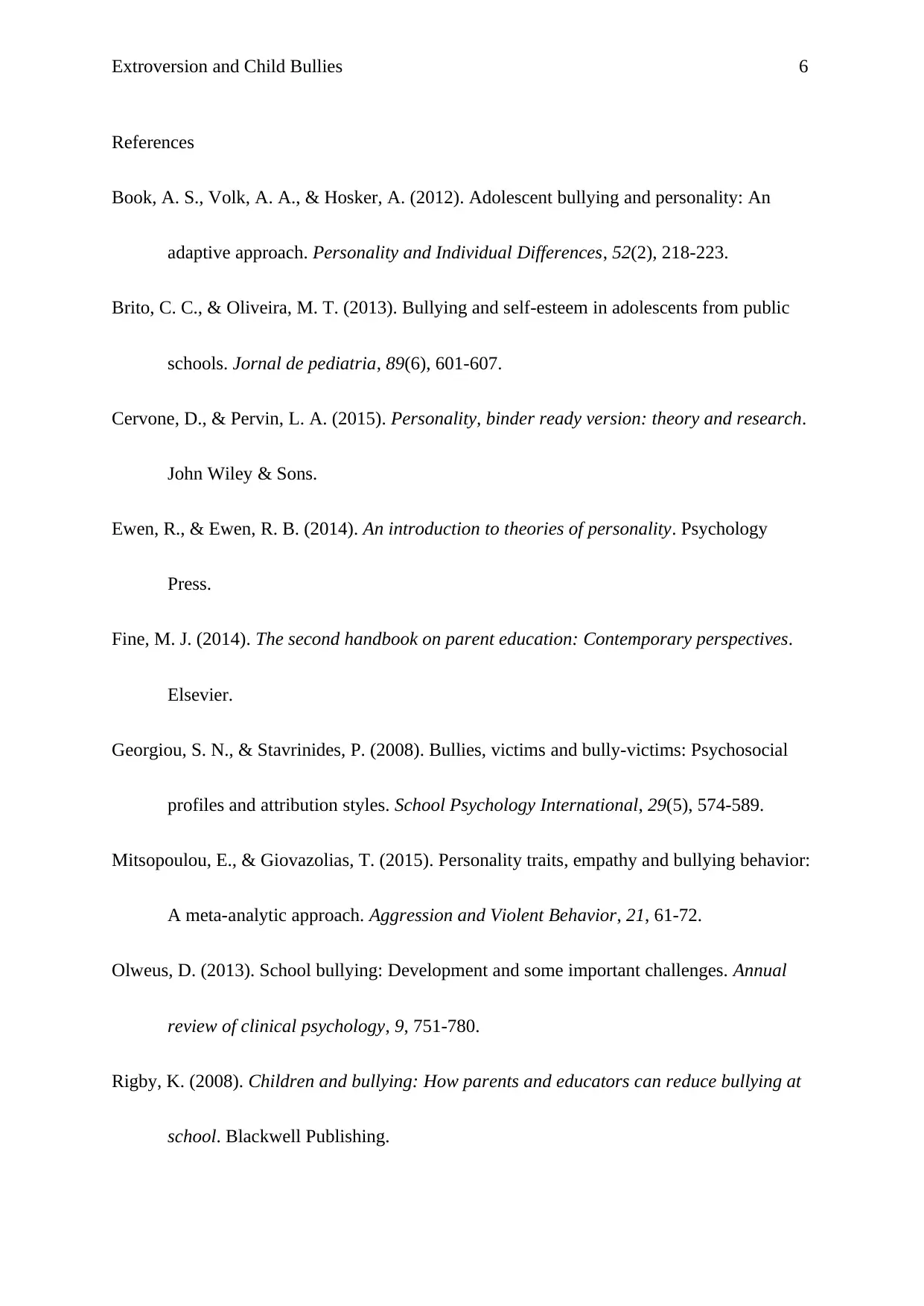
Extroversion and Child Bullies 6
References
Book, A. S., Volk, A. A., & Hosker, A. (2012). Adolescent bullying and personality: An
adaptive approach. Personality and Individual Differences, 52(2), 218-223.
Brito, C. C., & Oliveira, M. T. (2013). Bullying and self-esteem in adolescents from public
schools. Jornal de pediatria, 89(6), 601-607.
Cervone, D., & Pervin, L. A. (2015). Personality, binder ready version: theory and research.
John Wiley & Sons.
Ewen, R., & Ewen, R. B. (2014). An introduction to theories of personality. Psychology
Press.
Fine, M. J. (2014). The second handbook on parent education: Contemporary perspectives.
Elsevier.
Georgiou, S. N., & Stavrinides, P. (2008). Bullies, victims and bully-victims: Psychosocial
profiles and attribution styles. School Psychology International, 29(5), 574-589.
Mitsopoulou, E., & Giovazolias, T. (2015). Personality traits, empathy and bullying behavior:
A meta-analytic approach. Aggression and Violent Behavior, 21, 61-72.
Olweus, D. (2013). School bullying: Development and some important challenges. Annual
review of clinical psychology, 9, 751-780.
Rigby, K. (2008). Children and bullying: How parents and educators can reduce bullying at
school. Blackwell Publishing.
References
Book, A. S., Volk, A. A., & Hosker, A. (2012). Adolescent bullying and personality: An
adaptive approach. Personality and Individual Differences, 52(2), 218-223.
Brito, C. C., & Oliveira, M. T. (2013). Bullying and self-esteem in adolescents from public
schools. Jornal de pediatria, 89(6), 601-607.
Cervone, D., & Pervin, L. A. (2015). Personality, binder ready version: theory and research.
John Wiley & Sons.
Ewen, R., & Ewen, R. B. (2014). An introduction to theories of personality. Psychology
Press.
Fine, M. J. (2014). The second handbook on parent education: Contemporary perspectives.
Elsevier.
Georgiou, S. N., & Stavrinides, P. (2008). Bullies, victims and bully-victims: Psychosocial
profiles and attribution styles. School Psychology International, 29(5), 574-589.
Mitsopoulou, E., & Giovazolias, T. (2015). Personality traits, empathy and bullying behavior:
A meta-analytic approach. Aggression and Violent Behavior, 21, 61-72.
Olweus, D. (2013). School bullying: Development and some important challenges. Annual
review of clinical psychology, 9, 751-780.
Rigby, K. (2008). Children and bullying: How parents and educators can reduce bullying at
school. Blackwell Publishing.
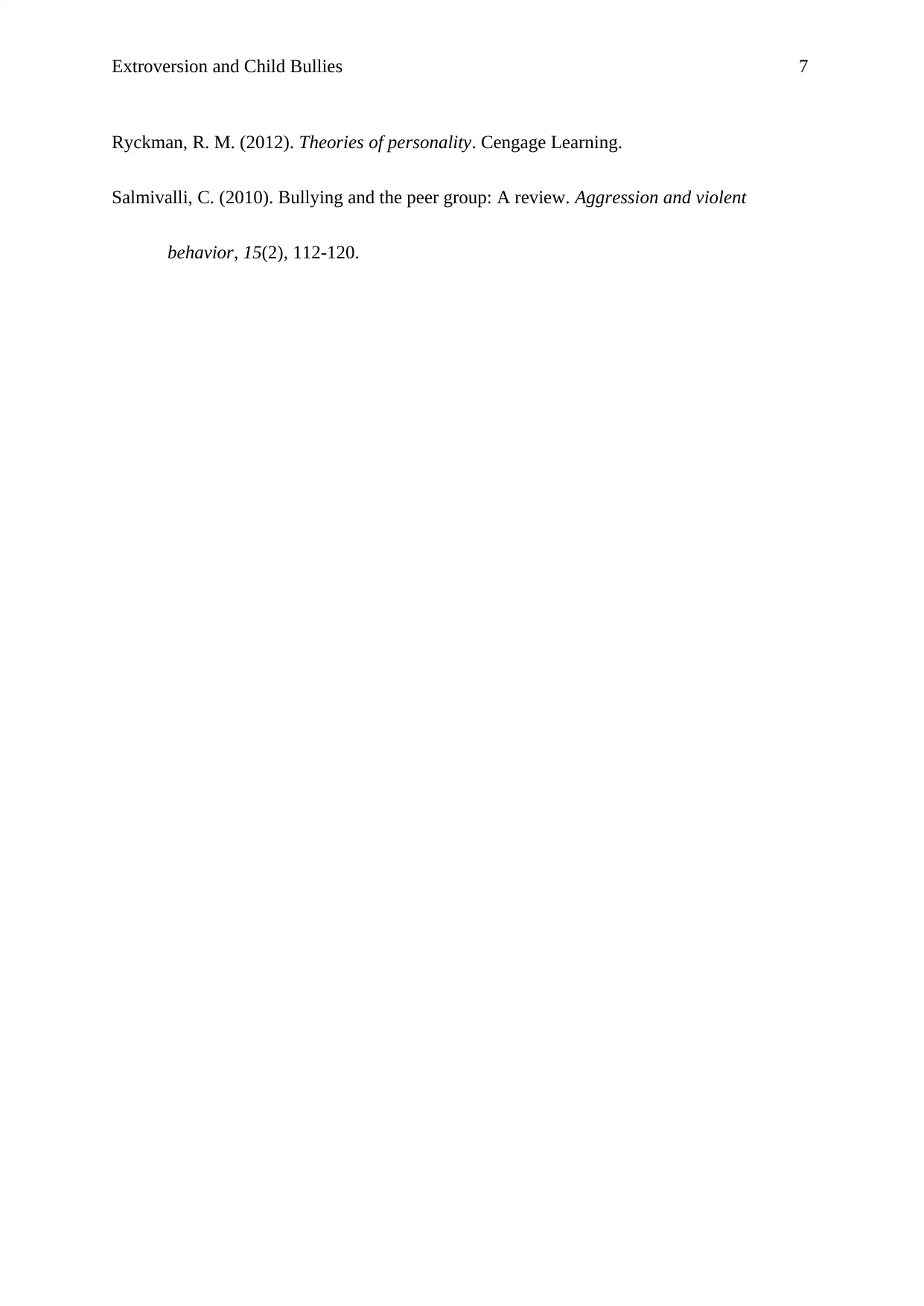
Extroversion and Child Bullies 7
Ryckman, R. M. (2012). Theories of personality. Cengage Learning.
Salmivalli, C. (2010). Bullying and the peer group: A review. Aggression and violent
behavior, 15(2), 112-120.
Ryckman, R. M. (2012). Theories of personality. Cengage Learning.
Salmivalli, C. (2010). Bullying and the peer group: A review. Aggression and violent
behavior, 15(2), 112-120.
1 out of 7
Your All-in-One AI-Powered Toolkit for Academic Success.
+13062052269
info@desklib.com
Available 24*7 on WhatsApp / Email
![[object Object]](/_next/static/media/star-bottom.7253800d.svg)
Unlock your academic potential
© 2024 | Zucol Services PVT LTD | All rights reserved.

